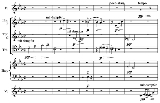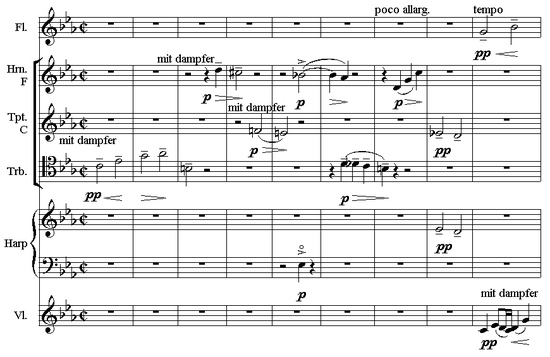
Klangfarbenmelodie
Encyclopedia
Klangfarbenmelodie is a music
al technique that involves distributing a musical line or melody
to several instrument
s, rather than assigning it to just one instrument, thereby adding color (timbre
) and texture to the melodic line. The technique is sometimes referred to as "Pointillism
", a term borrowed from a neo-impressionist painting technique.
The term was coined by Arnold Schoenberg
in his text on harmony
, Harmonielehre (1911), where he discusses the creation of "timbre-structures." Schoenberg and Anton Webern
are particularly noted for their use of the technique, Schoenberg most notably in the third of his Five Pieces for Orchestra
(Op. 16), and Webern in his Op. 10 (likely a response to Schoenberg's Op. 16), his Concerto for Nine Instruments (Op. 24), the Op. 11 pieces for cello
and piano
, and his orchestration
of the six-part ricercar
from Bach's
Musical Offering
:
 This may be compared with Bach's open score of the subject and the traditional homogeneous timbre used in arrangements:
This may be compared with Bach's open score of the subject and the traditional homogeneous timbre used in arrangements:
 Notable examples of such voice distribution that preceded the use of the term are Berlioz
Notable examples of such voice distribution that preceded the use of the term are Berlioz
' Symphonie Fantastique
where, in the fourth movement (March to the Scaffold, bars 109-112), the melody is passed between the strings and the winds several times; and the works of Claude Debussy
. Regarding the latter, Samson writes: "To a marked degree the music of Debussy elevates timbre to an unprecedented structural status; already in Prélude à l'après-midi d'un faune
the color of flute
and harp
functions referentially."
In the 1950s, the concept inspired a number of European composers including Karlheinz Stockhausen
to attempt systematization of timbre along serial
lines, especially in electronic music
.
The French term mélodie de timbres is essentially synonymous and was used by Olivier Messiaen
to describe his Couleurs de la cité céleste.
Isao Tomita
uses the technique in his works, although rather than employing musical instruments he uses different synthesizer
voices; Frank Zappa
used the term "Klangfarbenmusik" to describe his instrumental piece "Alien Orifice" from the album Frank Zappa Meets the Mothers of Prevention
.
Music
Music is an art form whose medium is sound and silence. Its common elements are pitch , rhythm , dynamics, and the sonic qualities of timbre and texture...
al technique that involves distributing a musical line or melody
Melody
A melody , also tune, voice, or line, is a linear succession of musical tones which is perceived as a single entity...
to several instrument
Musical instrument
A musical instrument is a device created or adapted for the purpose of making musical sounds. In principle, any object that produces sound can serve as a musical instrument—it is through purpose that the object becomes a musical instrument. The history of musical instruments dates back to the...
s, rather than assigning it to just one instrument, thereby adding color (timbre
Timbre
In music, timbre is the quality of a musical note or sound or tone that distinguishes different types of sound production, such as voices and musical instruments, such as string instruments, wind instruments, and percussion instruments. The physical characteristics of sound that determine the...
) and texture to the melodic line. The technique is sometimes referred to as "Pointillism
Pointillism
Pointillism is a technique of painting in which small, distinct dots of pure color are applied in patterns to form an image. Georges Seurat developed the technique in 1886, branching from Impressionism. The term Pointillism was first coined by art critics in the late 1880s to ridicule the works...
", a term borrowed from a neo-impressionist painting technique.
The term was coined by Arnold Schoenberg
Arnold Schoenberg
Arnold Schoenberg was an Austrian composer, associated with the expressionist movement in German poetry and art, and leader of the Second Viennese School...
in his text on harmony
Harmony
In music, harmony is the use of simultaneous pitches , or chords. The study of harmony involves chords and their construction and chord progressions and the principles of connection that govern them. Harmony is often said to refer to the "vertical" aspect of music, as distinguished from melodic...
, Harmonielehre (1911), where he discusses the creation of "timbre-structures." Schoenberg and Anton Webern
Anton Webern
Anton Webern was an Austrian composer and conductor. He was a member of the Second Viennese School. As a student and significant follower of Arnold Schoenberg, he became one of the best-known exponents of the twelve-tone technique; in addition, his innovations regarding schematic organization of...
are particularly noted for their use of the technique, Schoenberg most notably in the third of his Five Pieces for Orchestra
Five Pieces for Orchestra
The Five Pieces for Orchestra Op. 16 was composed by Arnold Schoenberg in 1909. The titles of the pieces, reluctantly added by the composer after the work's completion upon the request of his publisher, are as follows:...
(Op. 16), and Webern in his Op. 10 (likely a response to Schoenberg's Op. 16), his Concerto for Nine Instruments (Op. 24), the Op. 11 pieces for cello
Cello
The cello is a bowed string instrument with four strings tuned in perfect fifths. It is a member of the violin family of musical instruments, which also includes the violin, viola, and double bass. Old forms of the instrument in the Baroque era are baryton and viol .A person who plays a cello is...
and piano
Piano
The piano is a musical instrument played by means of a keyboard. It is one of the most popular instruments in the world. Widely used in classical and jazz music for solo performances, ensemble use, chamber music and accompaniment, the piano is also very popular as an aid to composing and rehearsal...
, and his orchestration
Orchestration
Orchestration is the study or practice of writing music for an orchestra or of adapting for orchestra music composed for another medium...
of the six-part ricercar
Ricercar
A ricercar is a type of late Renaissance and mostly early Baroque instrumental composition. The term means to search out, and many ricercars serve a preludial function to "search out" the key or mode of a following piece...
from Bach's
Johann Sebastian Bach
Johann Sebastian Bach was a German composer, organist, harpsichordist, violist, and violinist whose sacred and secular works for choir, orchestra, and solo instruments drew together the strands of the Baroque period and brought it to its ultimate maturity...
Musical Offering
The Musical Offering
The Musical Offering , BWV 1079, is a collection of canons and fugues and other pieces of music by Johann Sebastian Bach, all based on a single musical theme given to him by Frederick II of Prussia , to whom they are dedicated...
:


Hector Berlioz
Hector Berlioz was a French Romantic composer, best known for his compositions Symphonie fantastique and Grande messe des morts . Berlioz made significant contributions to the modern orchestra with his Treatise on Instrumentation. He specified huge orchestral forces for some of his works; as a...
' Symphonie Fantastique
Symphonie Fantastique
Symphonie Fantastique: Épisode de la vie d'un Artiste...en cinq parties , Op. 14, is a program symphony written by the French composer Hector Berlioz in 1830. It is one of the most important and representative pieces of the early Romantic period, and is still very popular with concert audiences...
where, in the fourth movement (March to the Scaffold, bars 109-112), the melody is passed between the strings and the winds several times; and the works of Claude Debussy
Claude Debussy
Claude-Achille Debussy was a French composer. Along with Maurice Ravel, he was one of the most prominent figures working within the field of impressionist music, though he himself intensely disliked the term when applied to his compositions...
. Regarding the latter, Samson writes: "To a marked degree the music of Debussy elevates timbre to an unprecedented structural status; already in Prélude à l'après-midi d'un faune
Prélude à l'après-midi d'un faune
Prélude à l'après-midi d'un faune , commonly known by its English title Prelude to the Afternoon of a Faun, is a symphonic poem for orchestra by Claude Debussy, approximately 10 minutes in duration...
the color of flute
Flute
The flute is a musical instrument of the woodwind family. Unlike woodwind instruments with reeds, a flute is an aerophone or reedless wind instrument that produces its sound from the flow of air across an opening...
and harp
Harp
The harp is a multi-stringed instrument which has the plane of its strings positioned perpendicularly to the soundboard. Organologically, it is in the general category of chordophones and has its own sub category . All harps have a neck, resonator and strings...
functions referentially."
In the 1950s, the concept inspired a number of European composers including Karlheinz Stockhausen
Karlheinz Stockhausen
Karlheinz Stockhausen was a German composer, widely acknowledged by critics as one of the most important but also controversial composers of the 20th and early 21st centuries. Another critic calls him "one of the great visionaries of 20th-century music"...
to attempt systematization of timbre along serial
Serialism
In music, serialism is a method or technique of composition that uses a series of values to manipulate different musical elements. Serialism began primarily with Arnold Schoenberg's twelve-tone technique, though his contemporaries were also working to establish serialism as one example of...
lines, especially in electronic music
Electronic music
Electronic music is music that employs electronic musical instruments and electronic music technology in its production. In general a distinction can be made between sound produced using electromechanical means and that produced using electronic technology. Examples of electromechanical sound...
.
The French term mélodie de timbres is essentially synonymous and was used by Olivier Messiaen
Olivier Messiaen
Olivier Messiaen was a French composer, organist and ornithologist, one of the major composers of the 20th century. His music is rhythmically complex ; harmonically and melodically it is based on modes of limited transposition, which he abstracted from his early compositions and improvisations...
to describe his Couleurs de la cité céleste.
Isao Tomita
Isao Tomita
, often known simply as Tomita, is a Japanese music composer, regarded as one of the pioneers of electronic music and space music, and as one of the most famous producers of analog synthesizer arrangements...
uses the technique in his works, although rather than employing musical instruments he uses different synthesizer
Synthesizer
A synthesizer is an electronic instrument capable of producing sounds by generating electrical signals of different frequencies. These electrical signals are played through a loudspeaker or set of headphones...
voices; Frank Zappa
Frank Zappa
Frank Vincent Zappa was an American composer, singer-songwriter, electric guitarist, record producer and film director. In a career spanning more than 30 years, Zappa wrote rock, jazz, orchestral and musique concrète works. He also directed feature-length films and music videos, and designed...
used the term "Klangfarbenmusik" to describe his instrumental piece "Alien Orifice" from the album Frank Zappa Meets the Mothers of Prevention
Frank Zappa Meets the Mothers of Prevention
Frank Zappa Meets the Mothers of Prevention is a 1985 album by Frank Zappa. It was originally released in two slightly different versions in the US and Europe. The two versions were later combined and reissued on a compact disc: first in the US on Rykodisc in 1986 Frank Zappa Meets the Mothers of...
.

